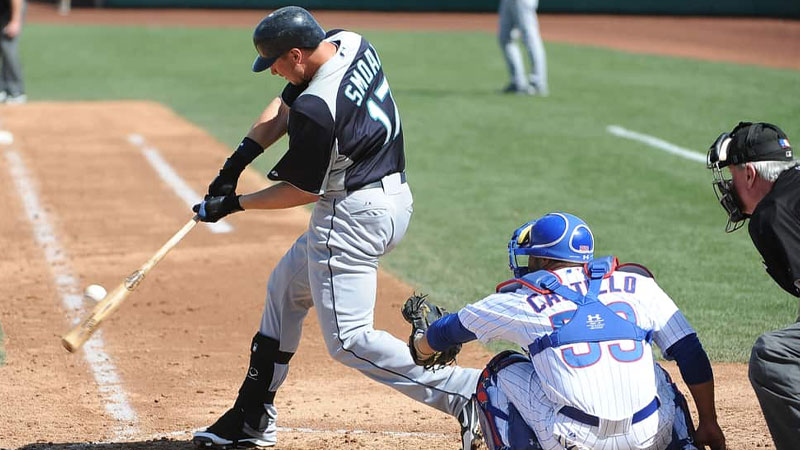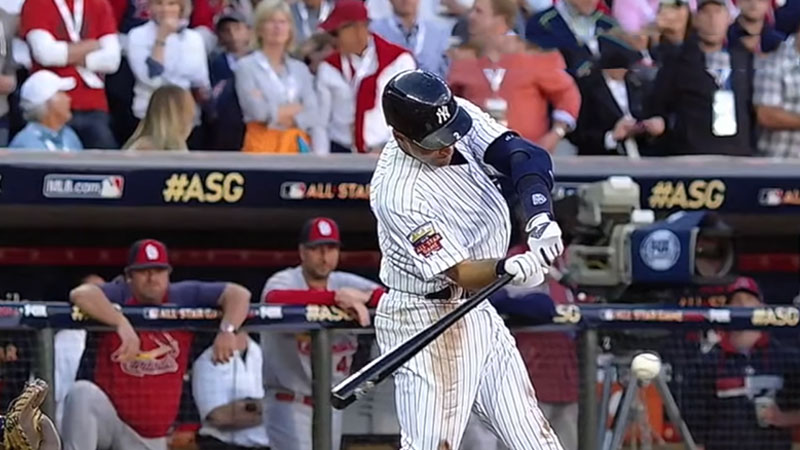In the world of baseball, hitting the ball with precision and power is the ultimate goal for every batter. One technique that has gained prominence among skilled hitters is the inside-out swing. So, what is an inside-out swing in baseball?
This particular approach allows batters to effectively drive the ball to the opposite field while maintaining excellent bat control.
In this article, we will delve into the intricacies of the inside-out swing, exploring its mechanics, benefits, and how it can enhance a hitter’s offensive prowess.
What Is An Inside-Out Swing In Baseball?
In baseball, an “inside-out swing” refers to a specific type of swing that a batter can use to hit the ball. It involves making contact with a pitch on the inner part of the plate and sending the ball to the opposite field, typically in the opposite direction of the batter’s natural hitting stance.
When a right-handed batter uses an inside-out swing, it means they are intentionally trying to hit the ball to right field. Conversely, a left-handed batter using an inside-out swing aims to hit the ball to left field.
The objective is to hit the ball with the barrel of the bat slightly before the plate and “inside” the ball, which produces a swing path that sends the ball to the opposite field.
This type of swing is often used by batters when they are trying to hit behind runners or advance a baserunner from second to third base with a hit to the right side of the field.
It requires the batter to have good hand-eye coordination, the ability to adjust their swing mid-flight, and the skill to hit the ball with the right amount of power and direction.
Mechanics of the Inside-Out Swing
Here’s how to utilize the inside-out swing while playing-
Stance and Approach
A batter utilizing the inside-out swing begins with a balanced and athletic stance. As the pitcher delivers the ball, the hitter tracks it closely, recognizing whether it’s on the inner half of the strike zone.
Hand Positioning and Load
The hands are crucial in executing the inside-out swing. The batter keeps their hands closer to their body and slightly further back than in a traditional swing. This positioning enables the hitter to stay inside the ball and make contact with pitches on the inner part of the plate.
Hip Rotation and Weight Transfer
As the pitch approaches, the hitter initiates the swing by rotating their hips toward the pitcher. Simultaneously, they transfer their weight from their back leg to the front leg, generating power and torque.
Bat Path and Contact Point
The key element of the inside-out swing is the bat path. Instead of taking a direct path toward the ball, the hitter aims to keep the barrel of the bat in the hitting zone for an extended period.
This allows for maximum bat control and the ability to hit pitches on the inner part of the plate while driving them toward the opposite field.
Benefits of the Inside-Out Swing
The inside-out swing in baseball offers several advantages for batters:

Source: baseballbible.net
Increased Plate Coverage
By utilizing the inside-out swing, hitters expand their plate coverage and become more effective at hitting pitches on the inner half of the strike zone. This makes it difficult for pitchers to exploit that part of the plate and gives the batter an advantage.
Hitting Against Defensive Shifts
In recent years, defensive shifts have become increasingly common in baseball. By mastering the inside-out swing, batters can counter these shifts effectively, hitting the ball where defenders are not positioned.
Bat Control and Adjustability
The inside-out swing demands excellent bat control, allowing hitters to adjust their swing mid-flight to make solid contact with different pitch locations.
This adaptability helps batters to combat various pitch types and speeds, making them more well-rounded and dangerous at the plate.
Generating Runs
Hitters who excel at the inside-out swing often find success in hitting for a high average and driving in runs. By consistently making contact and placing the ball in play, they create scoring opportunities for themselves and their teammates.
Inside-Out Swing Vs Regular Swing: Differences
Here are the key differences between an inside-out swing and a regular swing in baseball:
Contact Point
- Inside-Out Swing: The batter makes contact with the ball on the inner part of the plate, closer to its body.
- Regular Swing: The batter makes contact with the ball based on its location in the strike zone.
Direction of Hit
- Inside-Out Swing: The objective is to hit the ball to the opposite field from the batter’s natural hitting stance (right field for a right-handed batter, left field for a left-handed batter).
- Regular Swing: The direction of the hit depends on the pitch location and the batter’s natural stance (pulling the ball to the same side as their hitting stance or hitting it to the opposite field).
Purpose
- Inside-Out Swing: Often used to hit behind runners, advance baserunners, or execute a hit-and-run play.
- Regular Swing: Used to generate power and drive the ball with maximum force, potentially hitting for extra bases or home runs.
Swing Path
- Inside-Out Swing: The swing path starts from inside the ball, with the bat driving towards the opposite field.
- Regular Swing: The swing path is typically more direct towards the ball, with the bat path varying depending on the pitch location.
Bat Angle
- Inside-Out Swing: The bat angle is adjusted to make contact with the ball slightly before the plate, allowing for an inside-out path to the opposite field.
- Regular Swing: The bat angle may vary depending on the pitch location and the desired contact point, but the focus is on driving the ball with power.
Disadvantages of the Inside-Out Swing
While the inside-out swing in baseball has its advantages, it also carries certain disadvantages that batters should consider:
Power Limitation
The inside-out swing is primarily focused on making contact and hitting the ball to the opposite field. As a result, it often sacrifices power potential.
Batters using this swing may have difficulty generating the same level of power as they would with a regular swing, limiting their ability to hit for extra bases or drive in runs.
Pull-Side Vulnerability
By intentionally hitting the ball to the opposite field, batters using an inside-out swing may become more susceptible to pitches on the outer part of the plate.
They might have a harder time pulling the ball with authority to their natural hitting side, which could make them more predictable to pitchers who can exploit this tendency.
Limited Pull-Hitting Opportunities
The inside-out swing, by design, directs the ball to the opposite field. Batters who primarily use this swing might have fewer opportunities to take advantage of situations where a pulled hit is beneficial, such as driving runners home from third base or aiming for extra-base hits to their natural hitting side.
Timing Challenges
Executing a successful inside-out swing requires precise timing and hand-eye coordination. Batters must adjust their swing path and make contact slightly earlier to hit the ball on the inner part of the plate. This can be challenging, particularly against pitchers with deceptive deliveries or a wide variety of pitches.
Pitch Recognition Difficulty
Inside-out swings often require batters to recognize pitches early and adjust their swing accordingly. This can be challenging, especially when facing pitchers with a broad repertoire of pitches that move in different directions.
Batters using this swing must have exceptional pitch recognition skills to make proper contact and avoid swinging at pitches out of the strike zone.
Dependence on Opposite-Field Hitting
Relying too heavily on the inside-out swing may limit a batter’s ability to effectively hit their natural side. Over time, opposing teams may adjust their defensive alignment and pitch selection to exploit this tendency, potentially reducing the batter’s overall effectiveness at the plate.
FAQ
How can I develop an inside-out swing in baseball?
Developing an inside-out swing requires practice and attention to detail. Start with a balanced stance and keep your hands closer to your body. Focus on tracking pitches and recognizing the ones on the inner half of the strike zone.
Are there any specific drills to enhance the inside-out swing?
Yes, several drills can help improve your inside-out swing:
- Tee Drill: Set up a tee on the inner part of the plate and practice hitting the ball to the opposite field. Focus on keeping your hands inside the ball and driving it with controlled power.
- Soft Toss Drill: Have a partner toss balls from the side of you, simulating inside pitches. Practice hitting these pitches to the opposite field, emphasizing bat control and contact point.
Can the inside-out swing be effective against all pitch types?
The inside-out swing can be effective against various pitch types, but its success may vary depending on the specific pitch. It is particularly useful against inside fastballs, breaking balls, and changeups.
Is the inside-out swing suitable for all hitters?
The inside-out swing is a technique that can benefit most hitters, but it may be more advantageous for certain types of players. It is especially useful for contact hitters who prioritize making consistent contact and hitting for a high average.
Can the inside-out swing help with situational hitting?
Absolutely! The inside-out swing is valuable for situational hitting scenarios. When a runner is on base and the goal is to advance them or score, the inside-out swing allows the batter to hit behind the runner, guiding the ball to the opposite field and increasing the chances of moving the runner into the scoring position.
Final Words
So, now you know what is an inside-out swing in baseball. The inside-out swing is a valuable weapon in a hitter’s arsenal, enabling them to make solid contact with pitches on the inner half of the strike zone while effectively driving the ball to the opposite field.
By employing proper mechanics, focusing on bat control, and mastering the art of hitting against defensive shifts, batters can maximize their offensive potential.
As the game of baseball evolves, the inside-out swing remains a technique that sets skilled hitters apart, allowing them to thrive in various situations and contribute significantly to their team’s success.







